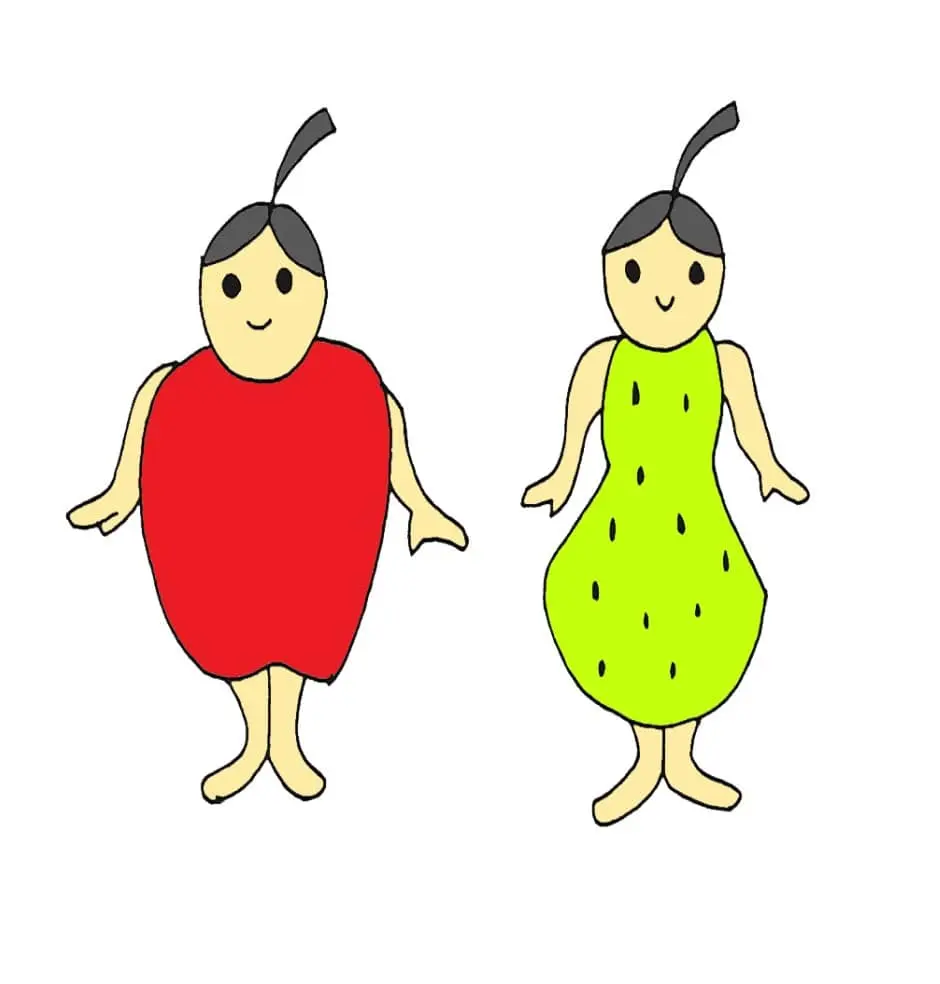
This post contains one of the most discussed and confused (among students) topic “The Constitution in Homoeopathy“.
So, today we will learn,
- What exactly the constitution is?
- How this concept evolved with time?
- How it develops in a person?
- Its importance in medical practice.
- Classification of constitution.
- Eduard Von Grauvogl’s classification of constitution.
- Importance of constitution in Homeopathy.
Table of Contents
ToggleWORD MEANING
The constitution word is a Latin derivative of “Constituere” or “Constitute” which means to set up, to make up or to establish.
It is the structure, composition, physical make up or nature of something consisting inherited qualities modified by environment.
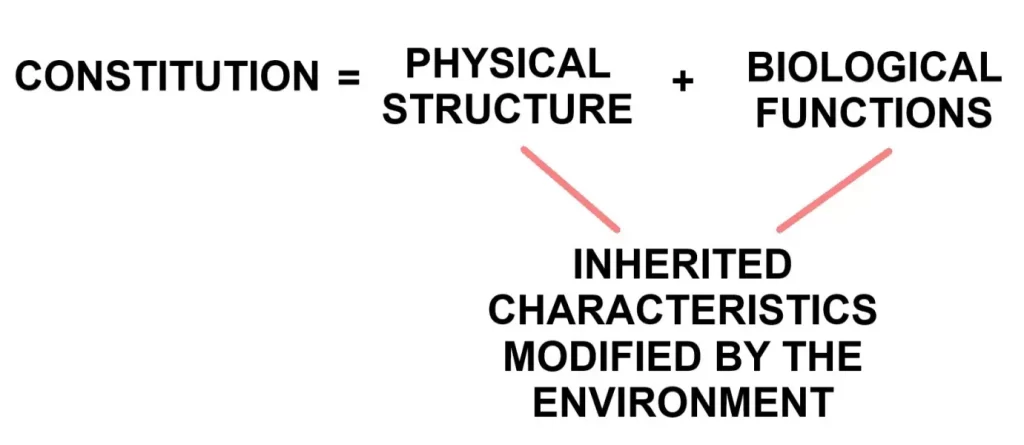
DEFINITION OF CONSTITUTION IN HOMOEOPATHY
Constitution is defined as the physical and mental makeup of a person which is expressed through his physical built, characteristics, desires, aversions, reactions including emotional and intellectual attributes.
Stuart close defines constitution as,
“Constitution is the aggregate of hereditary characters influenced more or less by the environment which determines the individual’s reaction, successful or unsuccessful to the stress of environment”.
Dr. James Tyler Kent says,
“Physical constitution is the external disorder following disorder in the man (person), the vital force”.
HISTORICAL INSIGHTS ON CONSTITUTION
According to Ayurveda, the constitution is known as DOSHA.
Three types are there- Vatha (Wind), Kapha (Water) and Pitha (Bile).
Hippocrates (460 BC- 377 BC) in his “Natura Medicatrix” says that each and every individual has his nature that cannot be changed.
He classified the constitution into Two types- Short and Thick and Long and Thin.
Aristotle (384 BC- 322 BC) was the first person in history who grouped individuals under different headings.
In his essays on “Physiognomy” he classified the human beings on the basis of Size, Built, Nature etc.
He also described the peculiar signs of the individual, of diseases and of humours.
Galen described the human constitution as Sanguine, Bilious, Phlegmatic and Nervous.
Dr. Christian Friedrich Samuel Hahnemann (1755-1843) who is the founder of homoeopathy, classified human constitutions into three groups- Psoric, Sycotic and Syphilitic.
Dr. Eduard Von Grauvogl (1811- 1877) who was a German Homoeopath classified the constitutions into three groups- Hydrogenoid (excess of water), Oxygenoid (excess of oxygen) and Carbo-nitrogenoid (excess of carbon and nitrogen in tissues and blood).
Count Cesar Mattei (1809-1896) divided human constitution into three broad groups- Sanguine (blood), Lymphatic (lymph) and Mixed (blood and lymph).
Dr. Leon Vannier (1880- 1963) who was a French homoeopath classified the human constitution into Carbonic, Phosphoric and Fluoric mainly based on the predominance of chemical elements.
Ernst Kretschmer (1888- 1964) he was a German psychiatrist.
He classified the constitution into three groups, Asthenic, Athletic and Pyknic.
- Asthenic (weak, schizophrenics)- Tall and thin, lean narrow physical built with poor skin secretions, narrow shoulders, muscles, delicate bones, narrow flat chest, sharp angles of ribs, thin stomach.
- Athletic-Strongly developed skeleton, musculature and skin. A middle-sized person with projecting shoulders, wide chest, firm stomach.
- Pyknic- Thick, maniac depressive, short and plump physique.
Dr. William Herbert Scheldon (1898-1977) classified the human body into three basic shapes known as “Somatotypes”- Ectomorph, Endomorph and Mesomorph.
- Ectomorph (Bony types)- Thin, tall and lean with not much muscles.
- Endomorph (Fatty type)-Wide bodied, Heavy set, person who is strong as a Bull.
- Mesomorph (Muscular type)- High percentage of muscles with little fat, small waist.
Bazin classified constitution into three types Scrofulous, Gouty and Syphilitic.
DISCUSSION ON CONSTITUTION
Before we go through the classification, we need to understand how the constitution develops?
ENDOGENOUS FACTORS
We receive few characters from our parents which are known as genetic characters, this is why we resemble like our father or mother.
⇓
ENVIRONMENTAL INFLUENCE
As we grow, we get exposed to different environmental conditions like house, school, playground, religion, the media, teachers, relatives and friend circles etc.
⇓
EXOGENOUS CHARACTERISTICS
We get influenced by them and mould our understanding and behavior pattern directly or indirectly.
Hence, we are what we have inherited from our ancestors, the things that we came across and the learning from our life experiences.
Some of us are prone to some diseases while some are prone to others. This selective affinity is known as our Susceptibility.
Susceptibility of a person also gets influenced by constitution.
WHY DO WE NEED TO CLASSIFY THE CONSTITUTION?
- The study of constitution can be compared with ‘Physiognomy’ which is an art of judging the character of something by their general appearance (face, physique etc). But, diagnosis of a person’s constitution is deeper than just Physiognomy.
- Every person inherits some characters from their parents and some characters are acquired from the surrounding environment. So, constitution is the mixture of the internal and external characteristics of an individual.
- A homeopath tries to individualize a patient based on his physical make up, his morals, social behavior, his desires and aversions etc. So, the knowledge of constitution helps in individualization of patient.
- The diagnosis of a person’s constitution helps in selection and prescribing remedies, to decide the dose and potency of selected medicine and ultimately for the treatment of the diseases.
- In Homeopathy, the nature of patient is diagnosed by his Heredity, Susceptibility, Temperament, Miasms, Diathesis and the predominant conditions of mind and body.
DR. EDUARD VON GRAUVOGL’S CLASSIFICATION OF CONSTITUTION
He was a German homeopathic physician.
In 1870, he classified human constitution into three different types.
- Carbo-nitrogenoid constitution
- Oxygenoid constitution
- Hydrogenoid constitution
This classification is widely accepted by most of the homeopaths.
This is based on different biochemical content of the body.
Dr. J.H. Clarke in his book “Constitutional remedies” explained about these classifications of Grauvogl.
We can also find Homoeopathic constitutional remedies based on this classification.
According to Grauvogl,
Every living organism is made up of oxygen, carbon, nitrogen and hydrogen.
↓
The excess or deficiency of these elements in the tissues.
↓
Development of different individual constitution.
1. CARBO-NITROGENOID CONSTITUTION
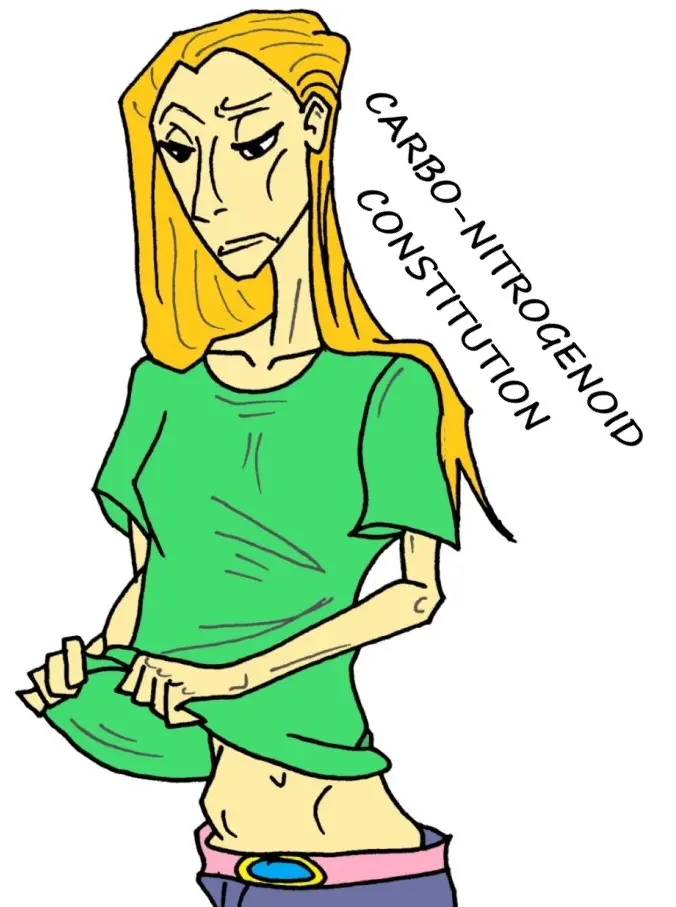
This is caused by an excess of carbon and nitrogen.
PATHOPHYSIOLOGY
Excess of carbon and nitrogen.
↓
Tissues cannot absorb sufficient oxygen.
↓
Insufficient oxygenation causes lack of nutrients.
↓
which leads to deficiency disorders.
↓
This leads to functional impairments.
- At the same time, carbo-nitrogenous matter accumulates and retention happens.
PHYSICAL FEATURES
- Marked obesity, followed by emaciation in later stage.
- Skin- Dirty and unhealthy with very offensive perspiration.
- Nail- Dry, brittle, often found longitudinally striated.
CLINICAL FEATURES
- Disturbed functions of mind and bodily organs like heart, lungs, kidneys, spleen, stomach etc.
- Pulse- Rapid.
- Respiration- Fast, shallow, restlessness.
- GIT- Flatulence, constipation or diarrhoea.
- Urinary- Increased uric acid and oxalates in urine, absence of chlorides.
- Nervous system- Vertigo, ataxia, fatigue, somnolence, yawning, epilepsy etc.
- Extremities- Gouty swellings, inflammatory nodosites at the small joints.
- Mind- Mostly tired individuals, dullness, Hypochondriacs, irritable and highly impatient.
MODALITIES
Aggravation by:
- Anything that increases the use of energy. Examples- Overeating, exertion, sexual excess etc.
- Everything which increases albuminoids and hydrocarbons.
- Everything which increases the alkalinity and decreases the acidity in the body.
Amelioration by:
- Rest, having sufficient sleep, balanced diet.
WHAT ARE MODALITIES IN HOMOEOPATHY?
RELATIONSHIP
Homoeopathic Remedies like ARSENICUM ALBUM, CALCAREA PHOS, CARBO VEG, HEPAR SULPH, IODUM, LYCOPODIUM CLAVATUM, NATRUM MUR, PHOSPHORUS, SULPHUR, ZINCUM MET etc. comes closer to this morbid constitution.
Carbo-nitrogenoid constitution closely resembles Dr. Hahnemann’s PSORIC constitution.
DIETETIC MANAGEMENT
- Foods like bread, cow’s milk, yogurt, butter, seasonal fruits, excess of liquid diet etc. should be encouraged.
- Foods like meat, pickles, coffee, bread, fats, bakery sweets etc. should be avoided.
2. OXYGENOID CONSTITUTION
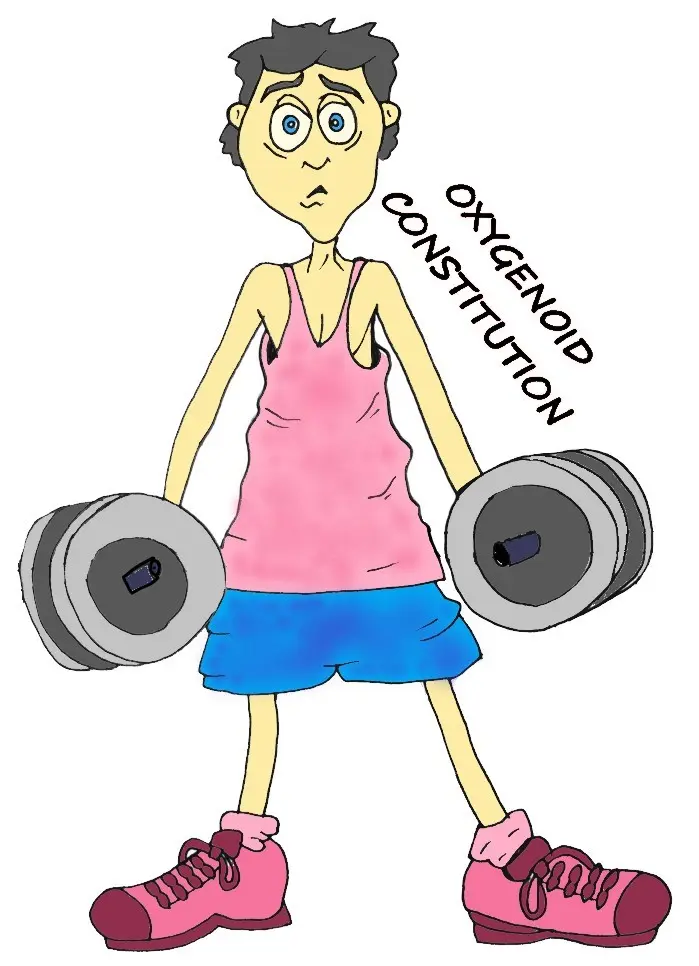
This type of constitution is caused by an excess of oxygen in the bodily tissues.
PATHOPHYSIOLOGY
The excess of oxygen exaggerates the breakdown of hydrocarbons, nitrogenoid substances and albumin compounds in tissues and bones.
↓
This rapid and incomplete breakdown disturbs the process of assimilation and growth.
↓
The cells cannot retain the necessary constituents.
↓
This causes demineralisation (to deal with deficiency).
↓
This leads to destruction of tissues and bones.
↓
Diminished resistance to toxins and poisons.
PHYSICAL FEATURES
- Body- Lean, thin, cachectic (weak and waste) and prone to ulcerations and self-destruction.
- They are scrofulous (enlarged glands and lymph nodes), rickety, anaemic and plethoric (excess of bodily fluids).
- Hands- Fusiform with elegant, round fingers.
- Nails-Beautiful, mostly long, sometimes numerous white spots on them.
CLINICAL FEATURES
- Nervous individuals with increased mental and physical activities.
- They are having vigorous appetite, even during illness.
- Patient feels better after rest and having foods.
- They feel strong animal heat after meals and feeble in the empty stomach.
MODALITIES
Aggravation by:
- Seashore (low altitude), empty stomach, change of weather, by cold, before and during storm, foggy weather, moving from dry to damp atmosphere.
Amelioration by:
- By taking food, by rest, in rains, cold weather, snowfall etc.
RELATIONSHIP
The Homoeopathic medicines like KALI IOD, KREOSOTUM, MERCURY, PETROLEUM etc. comes closer to this morbid state.
Oxygenoid constitution is closely resembles to Dr. Hahnemann’s “SYPHILITIC” constitution.
DIETETIC MANAGEMENT
- Foods like coffee, cold drinks, fatty food, pickles, sweets, meat etc. should be avoided.
- Foods like cow’s milk, fresh butter, sprouts, beans, wheat, jaggary, green leafy vegetables (especially spinach) should be encouraged.
3. HYDROGENOID CONSTITUTION
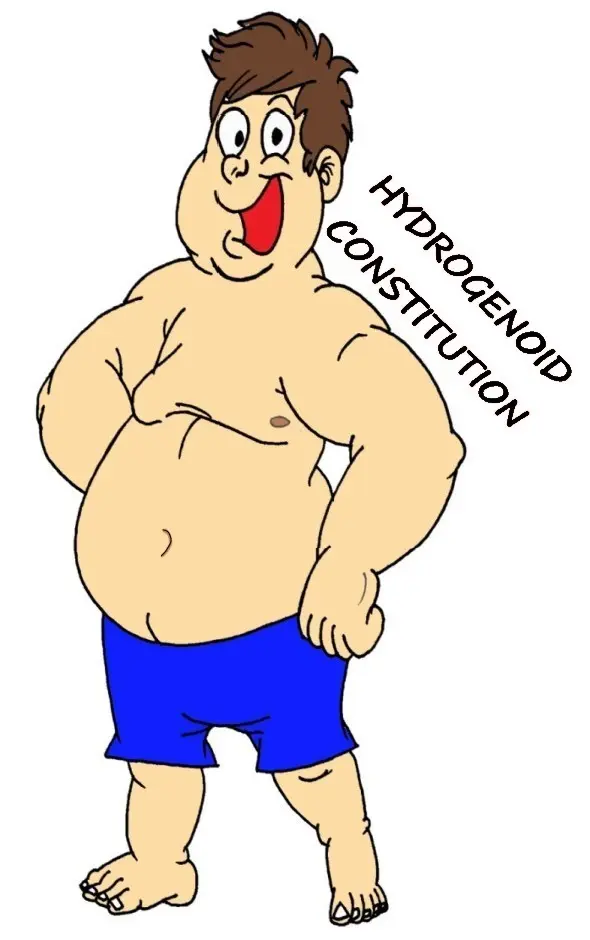
This type of constitution is caused by an excess of hydrogen which leads to retention of water in blood and tissues.
PATHOPHYSIOLOGY
More sodium ions are reabsorbed by the cell membranes and hydrogen ions are expelled into the filtrate.
↓
These hydrogen ions get combined with bicarbonate ions and forms carbonic acid.
↓
if this condition persists, blood becomes acidic.
PHYSICAL FEATURES
- Obese, round, short limbed and swollen bodily appearance.
- Hands- Oedematous, cold and humid.
- Skin- Clammy (wet from sweating).
CLINICAL FEATURES
- Slow intake of nutrients.
- Puffiness and retention of water in the bodily tissues.
- Symptoms get aggravated by everything which can increase the water molecules in the body. Example- bathing, eating seafood etc.
- The symptoms show periodicity and paroxysmal course.
- Patient is easily prone to oedema and anasarca (general swelling).
- Impaired renal functions.
- Complains having benign types of tissue growth.
- Patient is indolent (slothful), apathetic (indifferent, lack of concern), fatigued and slow.
- Patient looks like having no life.
- Nervous affections aggravated by electric disturbances.
MODALITIES
Aggravation by:
- Bathing, eating sea food, eating the vegetables which grow near the water or having high content of water, cold and damp weather, rain etc.
- Everything which decreases the alkalinity and increases the acidity in the body.
Amelioration by:
- in open air, warmth, movement, exposure to dry atmosphere etc.
RELATIONSHIP
- The homoeopathic medicines like NATRUM SULPH, THUJA, PULSATILLA etc. comes close to this type of morbid state.
- Hahnemann’s “SYCOTIC” constitution closely resembles this type of constitution.
- Not all the Sycotic remedies are of Hydrogenoid type.
DIETETIC MANAGEMENT
- Foods like sea food, wine, watery fruits and vegetables, cold drinks, meat etc. should be avoided.
- Foods like nuts, beans, wheat, rice, sprouts, seasonal fruits and vegetables etc. should be encouraged.
ROLE OF CONSTITUTION IN HOMEOPATHY
- Diagnosis of constitution helps to understand the peculiarity of an individual in both healthy and diseased state.
- This also helps to form the individualistic totality of a patient.
- In homoeopathy, a unique constitutional medicine is prescribed to each individual patient (after diagnosing the constitution).
- It is believed that applying constitutional medicine can correct the inherent and acquired defects of the patient.
- A well selected and deep acting potentised homoeopathic remedy is equal to the constitutional remedy. Example-Pulsatilla is well suitable to mild, gentle lady having blond hair, blue eyes and phlegmatic temperament.
Meaning of difficult words
- Aggregate: The total sum or combination of different elements.
- Hereditary: Traits or characteristics passed down from one’s ancestors or parents through genetic inheritance.
- Morbid: Relating to or characterized by disease or abnormality.
- Heredity: The passing on of physical or mental characteristics genetically from one generation to another.
- Susceptibility: The state of being prone to or easily affected by something, such as a disease or influence.
- Physiognomy: The practice of judging a person’s character or temperament based on their facial features or physical appearance.
- Individualization: The process of tailoring treatment or care to suit the unique characteristics or needs of an individual.
- Assimilation: The process of absorbing and integrating new information or experiences into one’s existing knowledge or understanding.
- Deminerlization: The loss or depletion of minerals from bodily tissues, particularly bones.
- Diatessaron: A disposition or tendency to develop a particular kind of disease or abnormal condition.
- Anasarca: Generalized swelling of the body due to excessive accumulation of fluid in the tissues.
- Apathetic: Showing or feeling little or no interest, enthusiasm, or concern.
- Paroxysmal: Occurring suddenly and unpredictably, often in recurring episodes or attacks.
- Indolent: Wanting to avoid activity or exertion; lazy.
- Sycotic: Relating to or characteristic of a medical condition characterized by abnormal growths or tumors.
- Pulsatilla: A homeopathic remedy derived from the plant Pulsatilla pratensis, used to treat various conditions such as menstrual disorders, respiratory issues, and emotional imbalances.
- Potentized: The process of diluting and succussing (shaking vigorously) a substance in homeopathy to create a potent remedy with therapeutic effects.

Thank you . Thank you so very much for doing this. It’s a huge huge help.
It’s very useful to understand Constitution.
Thank you Nital
Very helpful 😁😁😁
Very informative
Thank you Dr. Vaishali.
It was very helpful, it would be great if u could allso add the references to the above mentioned content.
very helpful
Please add more remedies for the three catagories which would be helpful .Nevertheless, the information that you have provided is of great help to me. Thanks.
I am glad to hear from you… your appreciation motivates me.
nice information well illustrated.
Very short, nice and informative content.
Thank you Dr. Motwani..
Thank you. It’s very useful to understand constitution easily.💫
Very helpful,logical,well explained.
Thanks a lot 😊
Very good coverage.Clears this highly confusing topic very well.Thanks alot.
Glad to hear from you…Thanks
Thank you for this article, it truly helpful
Thank you very much for nice explanation.
All the best to you.
Atiar.
Very helpful article. Thank you.
Thanks a lot this was very much helpful for us to understand the constitution.
Very helpful with concise, relevant and useful data.. Thanks a lot
Wonderful interpretation.
Best Wishes.
Thank you for this smart compilation.